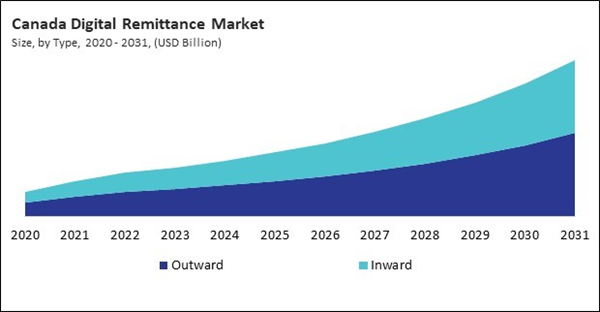The US market dominated the North America Digital Remittance Market by country in 2023, and is expected to continue to be a dominant market till 2031; thereby, achieving a market value of $16.56 billion by 2031. The Canada market is experiencing a CAGR of 15.8% during 2024-2031. Additionally, the Mexico market is expected to exhibit a CAGR of 16.5% during 2024-2031.
The extensive proliferation of smartphones and high-speed internet has significantly expedited the adoption of digital remittance services. With mobile technology becoming more accessible and affordable, even individuals in remote or underbanked regions can now access financial services through mobile wallets and digital payment apps.
Additionally, government and regulatory support is another crucial factor in expanding the digital remittance market. Regulatory frameworks such as open banking policies, Know Your Customer (KYC) compliance, and Anti-Money Laundering (AML) regulations encourage innovation while ensuring digital remittance transactions' security and transparency.
The digital remittance landscape in North America is experiencing significant growth, driven by various factors unique to each nation. The region's well-developed digital infrastructure and substantial expatriate population contribute to the increasing demand for efficient and secure cross-border money transfer services. The United States, hosting one of the world's largest immigrant populations, has seen a substantial rise in digital remittances. According to the World Bank, people in the nation received approximately USD 7.7 billion of personal remittances in 2023. Cross-border transactions are now more accessible and cost-effective due to technological improvements and the broad use of financial technology solutions. Innovations such as blockchain, artificial intelligence (AI), and machine learning have enhanced remittance services' efficiency, security, and speed, making them more attractive to users.
List of Key Companies Profiled
- Papaya Global Ltd.
- Digital Wallet Corporation
- WorldRemit Ltd.
- Nium Pte. Ltd.
- MoneyGram Payment Systems Inc.
- PayPal Holdings, Inc.
- Ria Financial Services Ltd.
- TransferGo Ltd.
- TransferWise Ltd.
- Western Union Holdings, Inc.
Market Report Segmentation
By Type
- Outward
- Inward
By Channel
- Money Transfer Operators
- Banks
- Online Platforms
- Other Channel
By End Use
- Personal
- Small Businesses
- Migrant Labor Workforce
- Other End Use
By Country
- US
- Canada
- Mexico
- Rest of North America
Table of Contents
Companies Mentioned
- Papaya Global Ltd.
- Digital Wallet Corporation
- WorldRemit Ltd.
- Nium Pte. Ltd.
- MoneyGram Payment Systems Inc.
- PayPal Holdings, Inc.
- Ria Financial Services Ltd.
- TransferGo Ltd.
- TransferWise Ltd.
- Western Union Holdings, Inc.
Methodology

LOADING...









